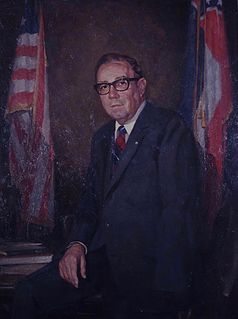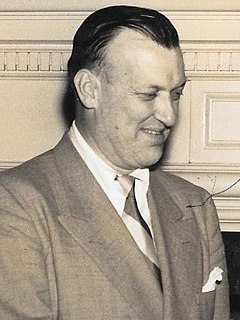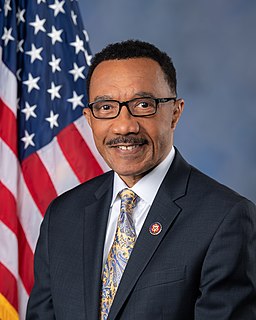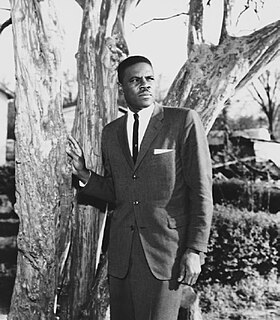Related Research Articles

John Bell Williams was an American Democratic politician who represented Mississippi in the U.S. House of Representatives from 1947 to 1968 and served as Governor of Mississippi from 1968 to 1972.

Theodore Roosevelt McKeldin was an American politician. He was a member of the Republican Party, served as mayor of Baltimore twice, from 1943 to 1947 and again from 1963 to 1967. McKeldin was the 53rd Governor of Maryland from 1951 to 1959.

Kweisi Mfume is an American politician who is currently serving as the U.S. representative for Maryland's 7th congressional district, first serving from 1987 to 1996, and again since 2020. A member of the Democratic Party, Mfume first left his seat to become the president and CEO of the National Association for the Advancement of Colored People (NAACP), a position he held from 1996 to 2004. In 2006, he ran for the U.S. Senate seat that was being vacated by Paul Sarbanes, narrowly losing the Democratic primary election to Ben Cardin. Mfume returned to his former House seat in 2020 after it was left vacant by the death of Elijah Cummings.
Murray v. Pearson was a Maryland Court of Appeals decision which found "the state has undertaken the function of education in the law, but has omitted students of one race from the only adequate provision made for it, and omitted them solely because of their color." On January 15, 1936, the court affirmed the lower court ruling which ordered the university to immediately integrate its student population, and therefore created a legal precedent making segregation in Maryland illegal.

Separate But Equal is a 1991 American two-part television miniseries depicting the landmark Supreme Court desegregation case Brown v. Board of Education, based on the phrase "Separate but equal". The film stars Sidney Poitier as lead NAACP attorney Thurgood Marshall, Richard Kiley as Chief Justice Earl Warren, Burt Lancaster as lawyer John W. Davis, Cleavon Little as lawyer and judge Robert L. Carter, and Lynne Thigpen as Ruth Alice Stovall.
Lillie May Carroll Jackson, pioneer civil rights activist, organizer of the Baltimore branch of the NAACP. Invariably known as "Dr. Lillie", "Ma Jackson", and the "mother of the civil rights movement", Lillie May Carroll Jackson pioneered the tactic of non-violent resistance to racial segregation used by Martin Luther King Jr. and others during the early civil rights movement.
Desegregation of the Baltimore City Public Schools took place in 1956 after the United States Supreme Court ruled, in the case of Brown v. Board of Education, that segregation in schools went against constitutional law. Desegregation of U.S. schools was part of the civil rights movement. The events that followed desegregation in Baltimore, were important to the civil rights movement across America. Recent scholarship has identified Baltimore's desegregation as an important precursor to the Greensboro sit-ins.

Gwynn Oak Park is a park that was the site of a privately owned amusement park, located in the community of Gwynn Oak, just outside northwest Baltimore, Maryland, in Baltimore County. The 64-acre (260,000 m2) park is at the corner of Gwynn Oak and Gwyndale avenues, about a quarter mile off of Liberty Heights Avenue. The amusement park, which existed from 1893 until 1973, was the site of protests against racial segregation due to a whites-only admissions policy.

The National Association for the Advancement of Colored People (NAACP) is a civil rights organization in the United States, formed in 1909 as an interracial endeavor to advance justice for African Americans by a group including W. E. B. Du Bois, Mary White Ovington, Moorfield Storey and Ida B. Wells.

The Morris A. Mechanic Theatre was a playhouse at 1 South Charles Street that was part of the Charles Center of Baltimore, Maryland. The theatre was built by and named for owner Morris A. Mechanic who operated a number of theatres in the city such as the Stanton, Fords Grand Opera House, The Centre, The Century/Valencia Theatres, all of which have since been demolished except for the Centre which the exterior has been restored and the interior has been repurposed as classroom and studio space for Maryland Institute College Of Art and Johns Hopkins University film programs. The Mechanic theatre was demolished in 2014.

Golden Asro Frinks was an American civil rights activist and a Southern Christian Leadership Conference (SCLC) field secretary who represented the New Bern, North Carolina SCLC chapter. He is best known as a principal civil rights organizer in North Carolina during the 1960s.
The following is a timeline of the history of the city of Baltimore, Maryland, USA.

Thomas Gillis Nutter was an attorney, businessman, and politician in Charleston, West Virginia, United States. Nutter is best remembered as a pioneer African-American member of the West Virginia Legislature, gaining election in 1918 and re-election in 1920 from an overwhelmingly white district, at a time when state disenfranchisement of blacks across the South had resulted in the exclusion of most blacks from statewide politics.
This is a timeline of the 1947 to 1968 civil rights movement in the United States, a nonviolent mid-20th century freedom movement to gain legal equality and the enforcement of constitutional rights for People of Color. The goals of the movement included securing equal protection under the law, ending legally established racial discrimination, and gaining equal access to public facilities, education reform, fair housing, and the ability to vote.

Adah Louise Killion Jenkins was a Civil rights activist, musician, teacher, and a music critic for the Afro-American newspaper.
George T. Raymond was an American civil rights leader from Pennsylvania who served as president of the Chester, Pennsylvania branch of the National Association for the Advancement of Colored People (NAACP) from 1942 to 1977. He was integral in the desegregation of businesses, public housing and schools in Chester and co-led the Chester school protests in 1964 which made Chester a key battleground in the civil rights movement.
Stanley E. Branche was an American civil rights leader from Pennsylvania who worked as executive secretary in the Chester, Pennsylvania branch of the National Association for the Advancement of Colored People (NAACP) and founded the Committee for Freedom Now (CFFN).
The Chester school protests were a series of demonstrations that occurred from November 1963 through April 1964 in Chester, Pennsylvania. The demonstrations focused on ending the de facto segregation that resulted in the racial categorization of Chester public schools, even after the landmark Supreme Court case Brown v. The Board of Education of Topeka (1954). The racial unrest and civil rights protests were led by Stanley Branche of the Committee for Freedom Now (CFFN) and George Raymond of the National Association for the Advancement of Colored Persons (NAACP).
The Committee for Freedom Now (CFFN) was an American civil rights organization in Chester, Pennsylvania, that worked to end de facto segregation and improve the conditions at predominantly black schools in Chester. CFFN was founded in 1963 by Stanley Branche along with the Swarthmore College chapter of Students for a Democratic Society and Chester parents. From November 1963 to April 1964, CFFN and the Chester chapter of the NAACP, led by George Raymond, initiated the Chester school protests which made Chester a key battleground in the civil rights movement.
The New Year's Day March in Greenville, South Carolina was a 1,000-man march that protested the segregated facilities at the Greenville Municipal Airport, now renamed the Greenville Downtown Airport. The march occurred after Richard Henry and Jackie Robinson were prohibited from using a white-only waiting room at the airport. The march was the first large-scale movement of the civil rights movement in South Carolina and Greenville. The march brought state-wide attention to segregation, and the case Henry v. Greenville Airport Commission (1961) ultimately required the airport's integration of its facilities.
References
- ↑ Scharf, John Thomas (1881). History of Baltimore City and County. Philadelphia: Louis Everts.
- ↑ Parren Mitchell, Oral History. 1976. OH 8170, Governor Theodore McKeldin-Dr. Lillie May Jackson Project. Maryland Historical Society.
- 1 2 Brown, Milton P. Letter to Mr. and Mrs. Sidney Hollander. Sidney Hollander Papers, MS 2044, March 4, 1949, MdHS
- 1 2 "After 6 Year At The Picket Line: MD's Ford Theatre Ends Separate Seating Policy". The Balto African American. February 9, 1952.
- ↑ "McKeldin Takes Initiative: Gov. Calls For Probe Of Ford's Theatre Bias". The Balto African-American. January 12, 1952.
- Galkin, Elliott W.; N. Quist. "Baltimore". New Grove Dictionary of Music and Musicians. pp. 611–612.